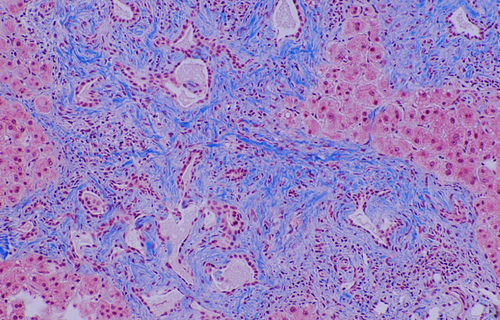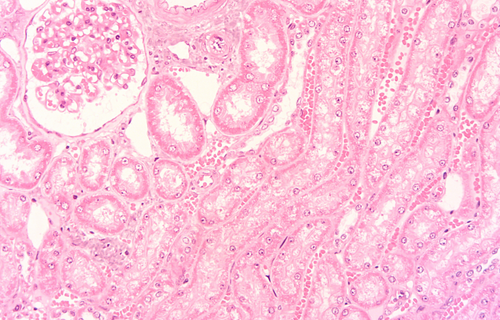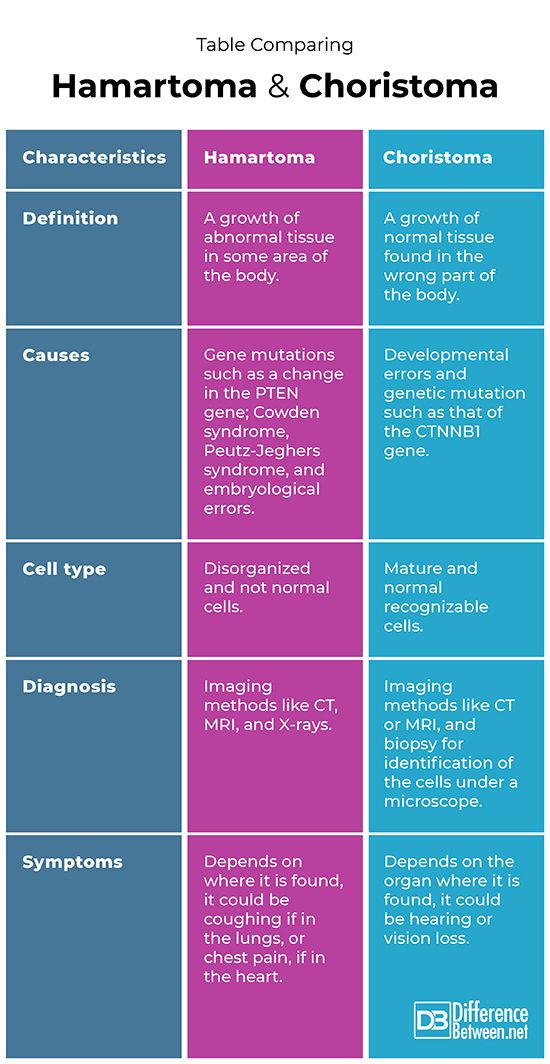Difference Between Hamartoma and Choristoma
A hamartoma is an unusual tissue growth in some part of the body. A choristoma is a growth of normal tissue that is in the incorrect location in the body.

What is Hamartoma?
Definition:
A hamartoma is a growth of tissue that is abnormal but not cancerous and the tissue is found in the part of the body it usually occurs in. These tissues grow in an unusual way and although not cancerous can, in time, change into a malignancy.
Causes:
Mistakes made during development can result in hamartomas, as can certain gene mutations. The PTEN gene stops the development of abnormal growths in the body (including tumors), so mutations of this gene can lead to hamartoma development. Hamartomas are also often due to certain medical conditions such as tuberous sclerosis or Peutz-Jeghers syndrome or Cowden syndrome.
Diagnosis:
Blood tests and imaging tests such as X-rays, CT scans, and MRIs can indicate the presence of a hamartoma. Further diagnostic methods are done depending on the organ where the growth is. For example, a lung hamartoma is also examined via bronchoscopy in addition to a chest X-ray.
Symptoms and complications:
Symptoms vary depending on where the hamartoma is (which organ is affected). A lung hamartoma produces symptoms like a cough and problems breathing; a heart hamartoma results in signs like chest pain and arrhythmia. Hamartomas can become cancerous or grow so big that they cut off the blood supply or compress other structures in the body, causing more complications.
Treatment:
Treatment may mean surgery. For example, a lung hamartoma is often cut out and, in some cases, the lobe or lung has to be removed.

What is Choristoma?
Definition:
A growth of what is normal cells and tissue but that is found in an abnormal place in the body.
Causes:
Choristomas are believed to result from a mistake made during development. It is commonly found in organs such as the mouth, tongue, ear, eyes, and skin. Genetic mutations such as the CTNNB1 gene have been linked to neuromuscular choristomas.
Diagnosis:
A choristoma may be detected by an imaging method such as an X-ray or CT scan, but a positive diagnosis is done by biopsy and microscopic examination of the removed tissue.
Symptoms and complications:
The symptoms depend on where the growth is. A growth in the ear would cause problems with hearing while one in the eye would cause problems with vision.
Treatment:
Choristomas are removed by surgery. They are cut out of the body and then the cells are examined using a microscope to ensure the structure is a choristoma.
Difference between Hamartoma and Choristoma?
Definition
A hamartoma is the growth of abnormal tissue in some part of the body. A choristoma is a growth of normal tissue found in the wrong part of the body.
Causes
Errors in development and mutations of the PTEN gene along with Cowden syndrome can cause a hamartoma. Developmental mistakes and mutation of the CTNNB1 gene can lead to a choristoma.
Cell type
A hamartoma has abnormal-looking cells that are not organized. A choristoma has normal type mature cells that are organized but found in the wrong part of the body.
Diagnosis
Imaging methods such as X-ray or CT can diagnose a hamartoma. A choristoma can be detected using imaging such as MRI or CT and then diagnosed by biopsy.
Symptoms
Symptoms of a hamartoma depend on where the mass is and can include coughing or chest pain. Symptoms of a choristoma can include hearing loss or vision loss depending on where it is.
Table comparing Hamartoma and Choristoma

Summary of Hamartoma Vs. Choristoma
- A hamartoma and choristoma are both growths of tissue that can be due to gene mutations.
- A hamartoma is tissue that is unusual in how it grows.
- A choristoma is normal tissue found in the wrong place.
- Surgical removal is done for both hamartomas and choristomas.
FAQ
What is the opposite of a hamartoma?
A normal growth of cells that does not produce a swollen structure.
What is the difference between neoplasm and hamartoma?
A neoplasm are cells that have grown out of control and continue to grow. A hamartoma is almost always benign while a neoplasm has quite a high chance of becoming a malignant cancer.
What is the meaning of the word hamartoma?
The word hamartoma is used to describe tissue that is malformed.
What is an example of hamartoma?
A Peutz-Jeghers polyp of the intestines is one example of a hamartoma.
What is the difference between hamartoma and benign tumor?
A hamartoma is only one type of benign tumor because it is a mass of tissue that is not malignant. A benign tumor also includes several other types of growths that can occur.
Is teratoma a choristoma?
No, a teratoma is a growth of the gonadal tissue only and it can sometimes be malignant. A choristoma is a benign growth of normal cells found in an odd place.
What is a trichilemmoma?
A trichilemmoma is a growth that comes from the hair follicles.
What is Cowden like syndrome?
This is a genetic disease that results in many hamartomas forming.
Is a hemangioma a hamartoma?
A hemangioma is a hamartoma made up of blood vessels.
What causes a hamartoma?
Developmental problems, certain disorders, and genetic mutations cause hamartomas.
Is teratoma benign or malignant?
A teratoma may be benign or malignant.
- Difference Between Rumination and Regurgitation - June 13, 2024
- Difference Between Pyelectasis and Hydronephrosis - June 4, 2024
- Difference Between Cellulitis and Erysipelas - June 1, 2024
Search DifferenceBetween.net :
References :
[0]Ali, Syed A., and Francesk Mulita. "Hamartoma." StatPearls (2020).
[1]Kim, Bong Hyun, and Bonnie A. Henderson. "Intraocular choristoma." Seminars in Ophthalmology. Vol. 20. No. 4. Taylor & Francis, 2005.
[2]Radosavljevic, Vojislav, et al. "Lung hamartoma-diagnosis and treatment." Medical Archives 66.4 (2012): 281.
